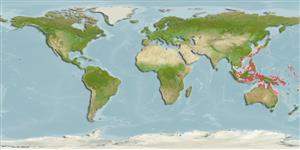>
Ovalentaria/misc (Various families in series Ovalentaria) >
Plesiopidae (Roundheads) > Plesiopinae
Etymology: Plesiops: Greek, plesios = near + Greek, ops = appearance (Ref. 45335); cephalotaenia: From the stripes on the head of the species (Ref. 27772).
Environment: milieu / climate zone / depth range / distribution range
Ecología
marino asociado a arrecife; rango de profundidad 0 - 12 m (Ref. 27772). Tropical
Western Pacific: Japan south to Australia; east to Solomon Is.
Tamaño / Peso / Age
Maturity: Lm ? range ? - ? cm
Max length : 7.7 cm TL macho / no sexado; (Ref. 90102)
Espinas dorsales (total) : 12; Radios blandos dorsales (total) : 6 - 7; Espinas anales: 3; Radios blandos anales: 7 - 10.
Adults occur inshore (Ref. 7300) at depths of 12 m or less in dead coral, reef flats, and on coral heads, habitats with somewhat less wave energy (Ref. 27772). Eggs are guarded by the male parent (Ref. 205).
Life cycle and mating behavior
Maturities | Reproducción | Spawnings | Egg(s) | Fecundities | Larva
Eggs are guarded by the male parent (Ref. 205).
Mooi, R.D., 1995. Revision, phylogeny, and discussion of biology and biogeography of the fish genus Plesiops (Perciformes: Plesiopsidae). Life Sci. Contrib. No. 159, 108 p. (Ref. 27772)
IUCN Red List Status (Ref. 130435)
Threat to humans
Harmless
Human uses
Herramientas
Special reports
Download XML
Fuentes de Internet
Estimates based on models
Preferred temperature (Ref.
123201): 26.2 - 29.3, mean 28.8 °C (based on 1571 cells).
Phylogenetic diversity index (Ref.
82804): PD
50 = 0.5000 [Uniqueness, from 0.5 = low to 2.0 = high].
Bayesian length-weight: a=0.00468 (0.00177 - 0.01234), b=3.18 (2.95 - 3.41), in cm total length, based on LWR estimates for this (Sub)family-body shape (Ref.
93245).
Nivel trófico (Ref.
69278): 3.4 ±0.5 se; based on size and trophs of closest relatives
Resiliencia (Ref.
120179): Alto, población duplicada en un tiempo mínimo inferior a 15 meses (Preliminary K or Fecundity.).
Fishing Vulnerability (Ref.
59153): Low vulnerability (10 of 100).
Nutrients (Ref.
124155): Calcium = 168 [86, 287] mg/100g; Iron = 0.824 [0.475, 1.399] mg/100g; Protein = 18.5 [17.4, 19.6] %; Omega3 = 0.102 [0.056, 0.189] g/100g; Selenium = 20.1 [8.8, 43.0] μg/100g; VitaminA = 161 [51, 493] μg/100g; Zinc = 2.05 [1.32, 3.00] mg/100g (wet weight);
